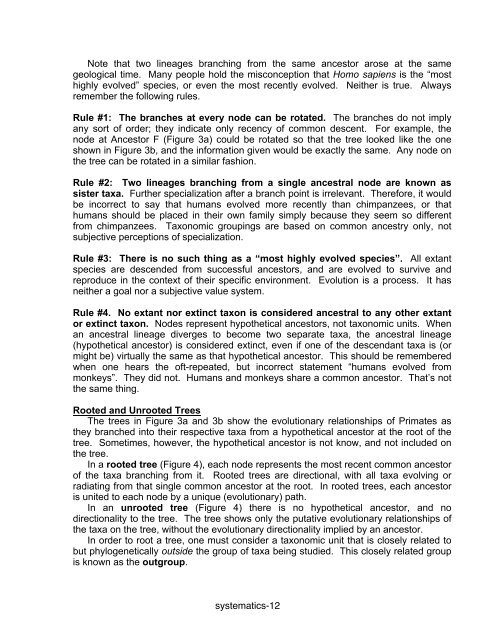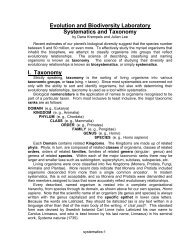Evolution and Biodiversity Laboratory Systematics and Taxonomy
Evolution and Biodiversity Laboratory Systematics and Taxonomy
Evolution and Biodiversity Laboratory Systematics and Taxonomy
Create successful ePaper yourself
Turn your PDF publications into a flip-book with our unique Google optimized e-Paper software.
Note that two lineages branching from the same ancestor arose at the samegeological time. Many people hold the misconception that Homo sapiens is the “mosthighly evolved” species, or even the most recently evolved. Neither is true. Alwaysremember the following rules.Rule #1: The branches at every node can be rotated. The branches do not implyany sort of order; they indicate only recency of common descent. For example, thenode at Ancestor F (Figure 3a) could be rotated so that the tree looked like the oneshown in Figure 3b, <strong>and</strong> the information given would be exactly the same. Any node onthe tree can be rotated in a similar fashion.Rule #2: Two lineages branching from a single ancestral node are known assister taxa. Further specialization after a branch point is irrelevant. Therefore, it wouldbe incorrect to say that humans evolved more recently than chimpanzees, or thathumans should be placed in their own family simply because they seem so differentfrom chimpanzees. Taxonomic groupings are based on common ancestry only, notsubjective perceptions of specialization.Rule #3: There is no such thing as a “most highly evolved species”. All extantspecies are descended from successful ancestors, <strong>and</strong> are evolved to survive <strong>and</strong>reproduce in the context of their specific environment. <strong>Evolution</strong> is a process. It hasneither a goal nor a subjective value system.Rule #4. No extant nor extinct taxon is considered ancestral to any other extantor extinct taxon. Nodes represent hypothetical ancestors, not taxonomic units. Whenan ancestral lineage diverges to become two separate taxa, the ancestral lineage(hypothetical ancestor) is considered extinct, even if one of the descendant taxa is (ormight be) virtually the same as that hypothetical ancestor. This should be rememberedwhen one hears the oft-repeated, but incorrect statement “humans evolved frommonkeys”. They did not. Humans <strong>and</strong> monkeys share a common ancestor. That’s notthe same thing.Rooted <strong>and</strong> Unrooted TreesThe trees in Figure 3a <strong>and</strong> 3b show the evolutionary relationships of Primates asthey branched into their respective taxa from a hypothetical ancestor at the root of thetree. Sometimes, however, the hypothetical ancestor is not know, <strong>and</strong> not included onthe tree.In a rooted tree (Figure 4), each node represents the most recent common ancestorof the taxa branching from it. Rooted trees are directional, with all taxa evolving orradiating from that single common ancestor at the root. In rooted trees, each ancestoris united to each node by a unique (evolutionary) path.In an unrooted tree (Figure 4) there is no hypothetical ancestor, <strong>and</strong> nodirectionality to the tree. The tree shows only the putative evolutionary relationships ofthe taxa on the tree, without the evolutionary directionality implied by an ancestor.In order to root a tree, one must consider a taxonomic unit that is closely related tobut phylogenetically outside the group of taxa being studied. This closely related groupis known as the outgroup.systematics-12

















